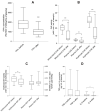Decrease in Cellular Nanovesicles Concentration in Blood of Athletes More Than 15 Hours After Marathon
- PMID: 33505159
- PMCID: PMC7829122
- DOI: 10.2147/IJN.S282200
Decrease in Cellular Nanovesicles Concentration in Blood of Athletes More Than 15 Hours After Marathon
Abstract
Introduction: Cellular nanovesicles (CNVs), that are shed from cells, have been recognized as promising indicators of health status. We analyzed the effect of long-distance running on concentration of CNVs, along with some standard blood parameters, in 27 athletes two days before and >15 hours after physical effort.
Methods: CNVs were isolated by repetitive centrifugation and washing of samples, and assessed by flow cytometry. Cholinesterase (ChE) and glutathione S-transferase (GST) activity were measured spectrophotometrically. Interleukin 6 (IL-6) and tumor necrosis factor-α (TNF-α) concentrations were measured using enzyme-linked immunosorbent assay (ELISA). C-reactive protein (CRP) was measured with immunoturbidimetric determination and lipidogram parameters were measured by enzymatic colorimetric assay. Flow cytometry was used for blood cell count and mean platelet volume (MPV) measurement.
Results: More than 15 hours after physical effort a decrease was found in CNVs' concentration in isolates from blood (46%; p<0.05), in ChE activity in whole blood (47%; p<0.001), in plasma (34%; p<0.01), and in erythrocyte suspension (54%; p<0.001), as well as in GST activity in erythrocyte suspension (16%; p<0.01) and in IL-6 concentration in plasma (63%; p<0.05). We found no change in GST activity in plasma and in TNF-α concentration in plasma. Correlations (>0.8; p<0.001) between CNVs' concentration and ChE activity, and GST activity, respectively, in erythrocyte suspension were found.
Conclusion: We found that >15 hours post-physical effort, CNVs' concentration was below the initial value, concomitant with other measured parameters: ChE and GST activity as well as IL-6 concentration, indicating a favorable effect of physical effort on health status. CNVs' concentration and ChE activity in isolates from peripheral blood proved to have potential as indicators of the response of the human body to inflammation after physical effort. Physical activity should be considered as an important factor in preparation of subjects for blood sampling in procedures focusing on CNV-containing diagnostic and therapeutic compounds.
Keywords: blood samples; cellular nanovesicles; inflammation process; marathon; membrane vesiculation; physical effort.
© 2021 Jan et al.
Conflict of interest statement
No conflicts of interest, financial or otherwise, are declared by the authors.
Figures



References
-
- Evelo CT, Palmen NG, Artur Y, Janssen GM. Changes in blood glutathione concentrations, and in erythrocyte glutathione reductase and glutathione S-transferase activity after running training and after participation in contests. Eur J Appl Physiol Occup Physiol. 1992;64(4):354–358. doi:10.1007/bf00636224 - DOI - PubMed
MeSH terms
Substances
LinkOut - more resources
Full Text Sources
Other Literature Sources
Medical
Research Materials
Miscellaneous

